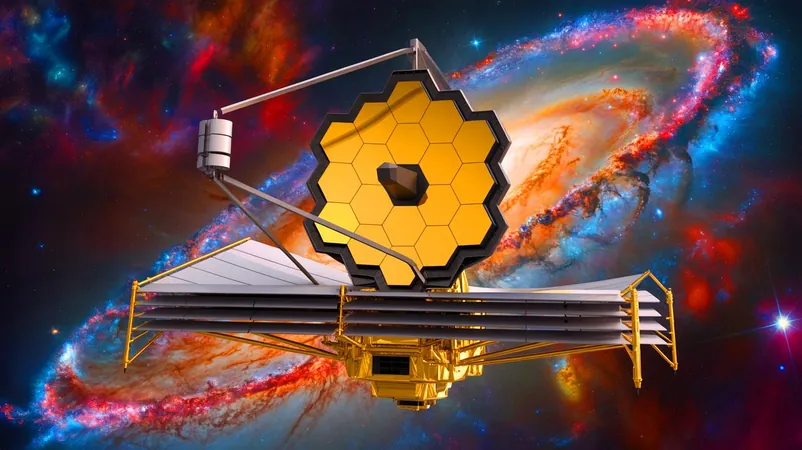
Revolutionary Discoveries: James Webb Telescope Exposes the Hidden Structures of Disk Galaxies!
2025-06-30
Author: Ken Lee
Unveiling Cosmic Secrets with the James Webb Space Telescope
The James Webb Space Telescope (JWST) is redefining our cosmic narrative, and its most recent revelations are nothing short of extraordinary! By focusing on disk galaxies, including our very own Milky Way, scientists are unlocking the mysteries of how these magnificent formations have developed over billions of years. These groundbreaking findings are reshaping our understanding of galactic history and the universe itself.
Exploring Galactic Origins
In a stunning breakthrough, the JWST observed 111 single and double-disk galaxies, looking back 3.8 billion years after the Big Bang. This unique vantage point enables researchers to trace the origins of our galaxy’s structure like never before. This marks the first instance of studying thick and thin disk structures at such vast distances, bridging an important connection between early universe observations and our own galaxy's evolution.
The Dual Structure of Disk Galaxies
Present-day disk galaxies typically exhibit a thick outer disk brimming with stars, alongside a thinner star-rich disk nestled within. The Milky Way’s thick disk spans about 3,000 light-years, while its thinner counterpart is around 1,000 light-years thick. Unraveling how these two disks form is crucial for understanding how galaxies evolve over cosmic time.
A Cosmic Timeline Revealed
One of the most significant discoveries from JWST data is that galaxies initially create a thick disk before forming a thinner one. High-mass galaxies underwent this transition to a two-disk structure around 8 billion years ago, while lower-mass galaxies developed their thin disks much later, about 4 billion years ago. This insight dramatically alters our understanding of the timeline of galactic formation.
Co-author Emily Wisnioski highlights the astonishing nature of observing thin stellar disks in existence as early as 8 billion years ago, which illuminates the evolutionary processes of galaxies. By integrating data from the Atacama Large Millimeter/submillimeter Array (ALMA) and ground-based surveys, the research team investigated gas dynamics in these galaxies, lending support to the chaotic gas disk theory.
The Turbulent Gas Disk Hypothesis Uncovered
The turbulent gas disk hypothesis posits that volatile gas disks in the nascent universe trigger intense star formation, leading to the emergence of a thick stellar disk. As stars form, they stabilize the gas disk, which gradually becomes less turbulent and thinner. Importantly, massive galaxies transition more swiftly into this mature state, allowing them to form thin disks earlier than their smaller counterparts.
Future Galactic Research on the Horizon
The research team, steered by Takafumi Tsukui, plans to enhance their work by incorporating more data into their galaxy sample. This will include metrics like stellar motion, age, and metallicity from nearby galaxies, facilitating a richer understanding of disk formation processes. The JWST, hailed as the premier observatory for space science, continues to unravel mysteries not just of our solar system but also of the vast expanse beyond, probing the ultimate origins of the universe.
With these pioneering insights into galactic structures, the future of cosmic exploration is extraordinarily promising! What more wonders will we unravel as we push the boundaries of our understanding of the universe?


 Brasil (PT)
Brasil (PT)
 Canada (EN)
Canada (EN)
 Chile (ES)
Chile (ES)
 Česko (CS)
Česko (CS)
 대한민국 (KO)
대한민국 (KO)
 España (ES)
España (ES)
 France (FR)
France (FR)
 Hong Kong (EN)
Hong Kong (EN)
 Italia (IT)
Italia (IT)
 日本 (JA)
日本 (JA)
 Magyarország (HU)
Magyarország (HU)
 Norge (NO)
Norge (NO)
 Polska (PL)
Polska (PL)
 Schweiz (DE)
Schweiz (DE)
 Singapore (EN)
Singapore (EN)
 Sverige (SV)
Sverige (SV)
 Suomi (FI)
Suomi (FI)
 Türkiye (TR)
Türkiye (TR)
 الإمارات العربية المتحدة (AR)
الإمارات العربية المتحدة (AR)